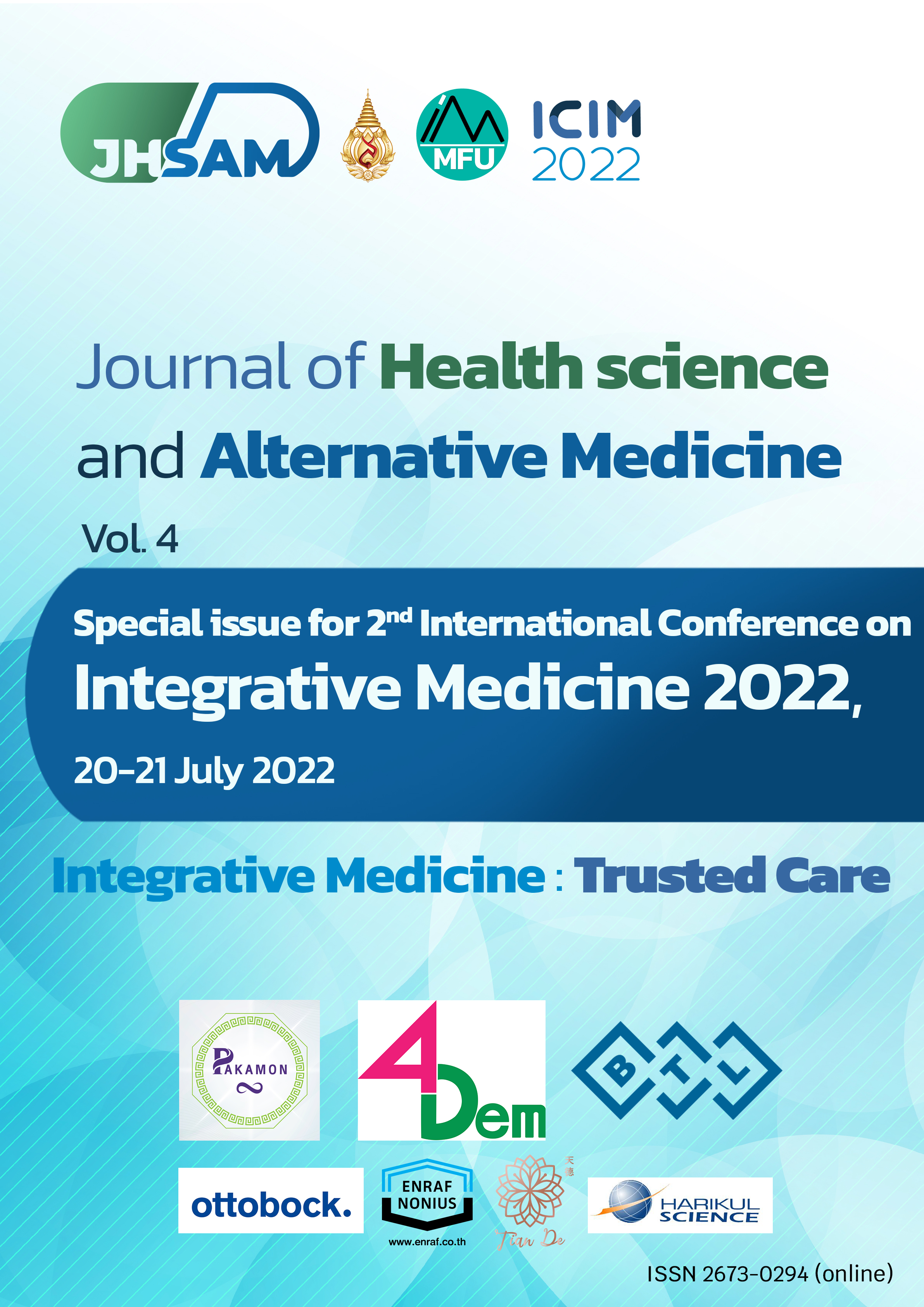D09. A Cross-sectional Survey of Traditional Chinese Medicine Constitution in Thailand's Type 2 Diabetic Population
Main Article Content
Abstract
Introduction: This paper uses "Traditional Chinese Medicine Constitution Classification and Judgment Table" to conduct a cross-sectional survey and research the traditional Chinese Medicine constitution in Thailand's type 2 diabetic population. Objective: To examine the TCM constitution of patients with type 2 diabetes in Thailand.
Methods: This study selected 424 Type 2 diabetes patients from January 2021 to July 2021 in Roi Et City, Thailand, Public Health Service Center, Traditional Chinese Medicine Outpatient Department, and Inpatient Department, Nakhon Ratchasima City, Thailand, Hua Laem Community, Don Thabuang Community, using "Traditional Chinese Medicine Constitution Classification and Judgment Table" for investigation, using Microsoft Excel to collect the general data and the distribution characteristics of TCM constitution, and SPSS 23 software for analysis.
Results: Among 424 people with type 2 diabetes in Thailand, Female patients were 58.96%, and Male patients were 41.04%. The age distribution is at most between 46-and 55 years old. For general data, Patients with a high BMI were 55.42%. The most significant number of cases in the distribution of TCM constitution is "Yin deficiency constitution," 30.2%. The highest distribution of syndrome types was "Qi and Yin deficiency syndrome," 39.7%. The difference was statistically significant (P<0.05).
Conclusion: "Yin deficiency constitution" and "Qi and Yin deficiency syndrome" is found the most in Thai type 2 diabetes patients. Gender, age, education level, diet, and BMI are the factors that affect the formation of the biased constitution in patients with type 2 diabetes.
Article Details

This work is licensed under a Creative Commons Attribution-NonCommercial-NoDerivatives 4.0 International License.
JHSAM publishes all articles in full open access, meaning unlimited use and reuse of articles with appropriate credit to the authors.
All our articles are published under a Creative Commons "CC-BY-NC-ND 4.0". License which permits use, distribution and reproduction in any medium,
provided that the original work is properly cited and is used for noncommercial purposes.
References
潘长玉. Joslin糖尿病学[M]. 北京: 人民卫生出版社, 2007. 180-181.
IDF Diabetes Atlas, seventh edition [EB/OL] [2015-121]. http://www.idf.org/diabetesatlas/.
陆菊明.中国2型糖尿病防治指南(2013年版)更新要点的解读[J].中国糖尿病杂志, 2014, 10: 865-869.
Xu Y, Wang L, He J,et al. Prevalence and control of diabetes in Chinese adults[J]. JAMA,2013, 310: 948-958.
Thai National Health Examination Survey V Study Group. Thai National Health Examination Survey, NHES V. Nonthaburi, Thailand: National Health Examination Survey Office, Health System Research Institute, 2016.
Yang W, Lu J, Weng J,et al. Prevalence of diabetetes among men and women in China[J]. N Engl J Med, 2010,25: 1090-0101.
虞晓含, 朱燕波, 王琦,等. 中医体质量表的项目反应理论分析[J]. 中医杂志, 2017, 58(1): 27-29.
朱文欣,黄家桓,林仕东等.不同中医体质老年 2 型糖尿病患者的心率变异性指标观察[J]. 新中医杂志, 2017, 49(12): 21-24.
韦兰香. 2型糖尿病湿热体质患者中医证候的相关性分析[D]. 广西中医药大学, 2018.
张晓林. 基于证素辨证的妊娠期糖尿病中医证型调查[D] .河南中医药大学, 2017.
邱昌龙, 田春雨, 李继安. 2型糖尿病中医证候研究概况[J]. 华北煤炭医学院中医系杂志, 2010.
林芳菲. 超重或肥胖对2型糖尿病并发症发病率的影响及其中医病因病机研究[D]. 辽宁中医药大学, 2016.
韦杰, 何苗, 汪龙, 等. ABO血型与糖尿病发生风险的meta分析[J].第二军医大学学报, 2016, 037(003): 309-315.
井延杰. 气虚体质2型糖尿病患者多因素相关性分析[D]. 云南中医学院, 2018.
刘仁权. SPSS统计软件[M]. 北京: 中国中医药出版社, 2011:168.

